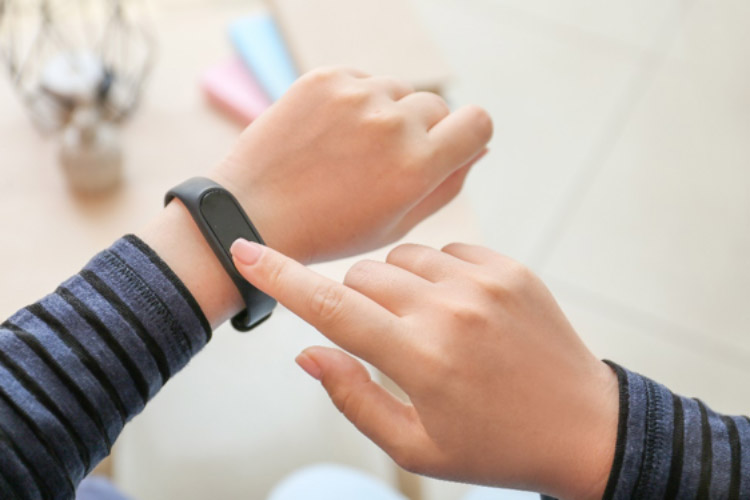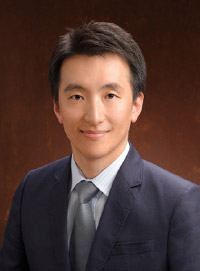
Collecting biomarkers by using a wearable wristband-type device © Pixel-Shot ― stock.adobe.com/jp
Taishiro Kishimoto is the head of Mori Building Co., Ltd. and Keio University's Hills Joint Research Laboratory for Future Preventive Medicine and Wellness, which aims to realize a society where people can expect to enjoy more active, healthier, and longer lives, both in body and mind, through interdisciplinary research that fuses advanced technology such as machine language processing with clinical psychiatry.
A career in psychiatry
As an undergraduate student, Kishimoto majored in the physical sciences but after two years decided to change to medicine. "After realizing that I preferred to study medicine, I sat the Keio University entrance exams and was accepted to enroll at the Keio University School of Medicine in 1994," says Kishimoto. "Upon graduating, I decided to specialize in psychiatry because my father is also a psychiatrist, and I knew what a career in this specialty would entail. I also enjoy seeing the dramatic changes in patients following treatment; the results are extremely clear in psychiatry. And, I wanted to contribute to our understanding of how the brain works and affects all aspects of our lives."
Psychiatry and the search for innovative biomarkers
Kishimoto explains that despite the wide range of biomarkers available for monitoring diseases afflicting, for example, the heart and kidneysーwhich are diagnosed based on an analysis of electrocardiogram and blood samplesーthere is only a very limited choice of biomarkers for monitoring psychiatric diseases.
"But it is clear that psychiatric diseases arise because something is happening in the brain," says Kishimoto. "So the challenge is to quantify and monitor what is happening in the brain in real time. I think that major advances in psychiatric research have been limited due to a lack of appropriate methods to measure these changes. About 70% to 80% of my research is focused on measuring the activities of patients in real time in the search for biomarkers that we may be able to correlate to their diseases."
However, Kishimoto stresses that the brain is complex, and it is not possible to understand it by only using a single biomarker. He is therefore collaborating with specialists from a wide range of backgrounds in a multi-disciplinary approach to find and monitor biomarkers that govern psychiatric diseases.
"One of my major projects is the use of wearable wristband-type devices to monitor the sleeping patterns and changes in heart rate during the daily activities of patients," explains Kishimoto. "We also use sticker-type sensors to monitor ECG heart signals and body sweat to gain insights into the fluctuations in a patient's autonomic nervous system during daily activities. We want to use the results for screening and diagnosis."
Biomarker projects in progress
Kishimoto and his group of 30 researchers are working on a wide range of other projects, including the analysis of the tone of a patient's voice during a conversation (phonetic information) and monitoring body movements and facial expressions.
"Another major pillar of my research is using natural language processing (NPL) to extract information about diseases based on the analysis of spoken language," says Kishimoto. "We have successfully identified and screened dementia using NPL technology, and we are at the development phase of medical devices with the possibility of using AI technology for treating dementia."
Kishimoto notes that it is not only important to monitor diseases, but that there is also a need to develop non-invasive wearable devices for the prevention of diseases such as depression in general public healthcare settings.
One of his recent and most challenging projects is related to the human microbiome (gut microorganisms). Kishimoto has been collecting samples from patients with depression, anxiety and neurodevelopmental disorder. "Understanding the role of gut microorganisms in modulating our psychological behavior could lead to the deeper understanding of the pathophysiology of psychiatric diseases and development of new approaches to treat them."
Kishimoto says that one of the difficulties of engaging in such a wide range of research projects is research management; specifically, in terms of the people, funding, and research activities. "I have 30 researchers in my group," explains Kishimoto. "Many of my colleagues recruit the subjects and obtain the data. In many cases, the data is labeled with clinical severity. The data is then analyzed by Data Scientists". Managing this process requires a tremendous amount of energy. Accurate ratings must be made for clinical labeling. To do this, it is necessary to create and maintain a group of excellent raters. An important step is to give the data analysts my view as a psychiatrist for their analyses. The context of the research is important in deriving meaningful conclusions."
Kishimoto adds that finding funding is a case of "sink or swim" to keep the projects going, and that he learned a lot about management during a three-and-a-half-year stint at a psychiatric hospital in New York where he specialized in clinical studies. "I learned a lot from the research coordinators working on large national projects," says Kishimoto. "This experience enabled me to assemble my research team at Keio University."
Recent research on innovative wearable devices for psychiatric applications
Depression is a universally known debilitating psychological disorder that affects millions of people worldwide to the detriment of their personal lives and with significant financial costs to national healthcare systems. Psychiatrists can treat the disease in a variety of ways including drugs, counseling, and even self-help courses. But psychiatrists can only treat someone once they visit their practice, when in some cases the symptoms may be chronic and patients may be experiencing stress discomfort. Notably, in contrast to other medical fields such as cardiology, which uses biomarkers for diagnosing and monitoring potential signs of disease, the psychiatrists do not have access to equivalent technology to monitor diseases in their field.
In a recent article published in Heliyon, Taishiro Kishimoto and colleagues at Keio University reported on combining multimodal wristband wearable devices and machine learning for screening the level of severity of depression in patients1.
The researchers fitted the wearable devices to 45 depressed and 41 healthy volunteers and monitored biomarkers that included their heart rates and sleep patterns for 5,250 hours. The data was analyzed using the XGBoost algorithm. The study indicated that machine learning analysis of the data accurately predicted whether an individual was depressed as well as the level of depression. Notably, the results showed that skin temperature was used as an important feature for predicting the state of depression.
The authors conclude that "that utilizing wearable devices and machine learning may be useful in identifying depression as well as assessing severity."
Published online 27 August 2021
About the researcher

Taishiro Kishimoto ― Project Professor (Non-tenured)
Keio University School of Medicine (Shinanomachi Campus), Hills Joint Research Laboratory for Future Preventive Medicine and WellnessTaishiro Kishimoto was born in Tottori, Japan, in 1973 and graduated from the Keio University School of Medicine in 2000. After he was awarded his Ph.D. degree from the Keio University School of Medicine in 2009, he took up a residency as a post-doctoral research fellow at the Zucker Hillside Hospital in New York, USA. After three and a half years, he moved back to Japan in 2013 and rejoined the Neuropsychiatry Department at the Keio University School of Medicine. As a principal investigator, he has led multiple government-funded studies, including a telemedicine project, an AI medical device development and IoT project for the healthy workplace (AMED), and a study on natural language processing utilization (JST-CREST).
Links
Reference
- Y. Tazawa, K. Liang, M. Yoshimura, M. Kitazawa, Y. Kaise, A. Takamiya, A. Kishi, T. Horigome, Y. Mitsukura, M. Mimura, T. Kishimoto, Evaluating depression with multimodal wristband-type wearable device: screening and assessing patient severity utilizing machine-learning. Heliyon. 6, e03274 (2020). | article